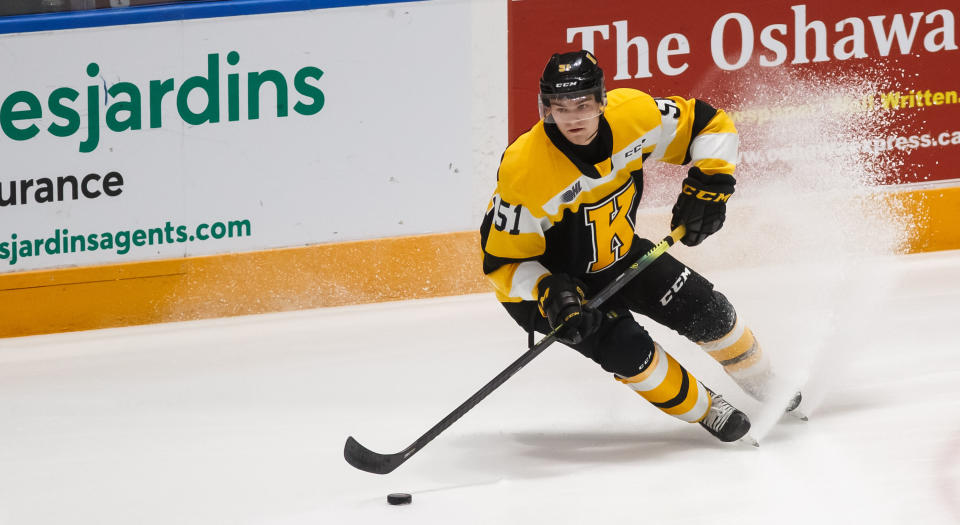Why Shane Wright is hockey's next super prospect

Stop if you’ve heard this specific type of Canadian hockey story before: A 15-year-old star bursts onto the scene after dominating at the Minor Midget level as an underage player in the Greater Toronto Hockey League. This player gains exceptional status from the Canadian Hockey League, elevating their profile to new heights before being anointed as hockey’s next great talent.
These are the routes that John Tavares and Connor McDavid took before entering the NHL, and both players exceeded the preposterous hype placed on them.
Enter Shane Wright, the third player to fit that description. Wright turned just 16 years old in January but is already absolutely dominating during his rookie season with the OHL’s Kingston Frontenacs after being selected first overall upon being granted said exceptional status.
Perhaps because of a few precautionary tales in the seven years separating McDavid from Wright, the latter hasn’t received the type of fanfare that his predecessors did. While exercising caution when evaluating any teenage hockey prospect is a good thing, it’s unnecessary in this case.
Wright is an absolute stud, and deserves to be skyrocketed into household territory as hockey’s next superstar.
McDavid and Tavares both became household names at the same age after tearing up the GTHL and gaining exceptional status. It’s worth examining their impact at the same age and it should be noted that all of these stats are unofficial.

Tavares played on what’s widely considered to be the most stacked minor hockey team ever, but was a force to be reckoned with. Although skating was a glaring weakness at this age, Tavares’ clinical finishing and natural goal-scoring ability was evident from the jump and he’s the player that essentially created the exceptional player program to begin with.
McDavid’s all-world talent was by far the easiest to recognize. At 15, he already possessed NHL-level speed and the sight of him barrelling down on helpless minor hockey defenders is a sight I can’t get out of my head. At the OHL Cup—Ontario’s showcase for minor midget talent before the players enter major junior—McDavid put on an absolute clinic, setting the tournament scoring record while fans and scouts were both left with their collective jaws dropped. Even at that age it was obvious he was destined to be an all-world player based on his skating and passing ability alone, and his future NHL superstardom was the easiest to discern out of any exceptional player.
Wright admittedly wasn’t as good—production wise, at least—as McDavid or Tavares at the same age but he’s combined both of their strengths. He’s an excellent skater with outstanding anticipation, boasting lower body strength that belies his age and an outstanding shot release. Like Tavares, Wright was the leader of a minor hockey juggernaut, leading his team to victory in the OHL Cup while falling just short of breaking McDavid’s tournament scoring record.
Whatever developmental gap there was between Wright and his predecessors is closing, however, if we use each of their OHL rookie seasons as a point of comparison.
*Wright’s stats current to March 2, 2020

Tavares assembled the best season ever for an underage player at the major junior level, but Wright, who has already matched McDavid, could eclipse the Maple Leafs’ captain by the end of this season, too. Using pace statistics as a predictive measure this late into the campaign isn’t always the best tool, but Wright is projected to hit 46 goals and 77 points in 64 games, which would put him right in line with Tavares for the best rookie season ever by an underage player.
To consider, Wright is expected to finish the season with more goals (albeit with far less points) than Marco Rossi and Cole Perfetti, both of whom are widely expected to be selected as top-10 picks in this summer’s NHL Draft. Wright won’t be eligible until 2022. Insanity.
What Makes Wright’s Game So Special
His spatial awareness, hockey intelligence and shooting ability are exceptional for someone his age, and he’s able to create chances with increased ease in the OHL. His quick release allows him to make the most of chances, and he’s particularly outstanding at navigating 2-on-1 chances.
THE PRICE IS WRIGHT.
Shane Wright has a lovely release. Quick release. Such a joy to watch. #2022NHLDraft pic.twitter.com/xPusa9YNOZ— Josh Tessler (@JoshTessler_) February 25, 2020
He just turned 16 in January but Wright’s anticipatory instincts resemble a player several years older, a trait that will age well as he continues to round out his game. Wright is often seen finding gaps before defenders realize he’s open and his excellent acceleration allows him to gain separation before getting his laser-quick shot off.
Shane Wright registered THREE points on his team’s four goals in yesterday’s game vs Mississauga. Wright now has:
32G 23A 55PTS 47GP (yes actually)
Wright is my #1 for the #2022NHLDraft pic.twitter.com/R9PRTUoIYs— TPEHockey (@TPEHockey) February 13, 2020
Wright is as sturdy as it gets on his feet for someone his age, but like all 16-year-old prospects, it’ll be compelling to see how his game fully evolves as he gets stronger. And while we ought to be cautious forecasting the future, it’s easy to see his game translating to a superstar trajectory in the NHL.
Alexis Lafreniere hasn’t been drafted yet but is the crown jewel of the 2020 class. The early returns on the 2021 Draft hasn’t produced much fanfare, but Wright will have competition for his title as hockey’s next super prospect in 2022.
Matthew Savoie of the WHL’s Winnipeg Ice and Brad Lambert of Finland’s HIFK are often mentioned in tandem with Wright when discussing the future of hockey. Both Savoie and Lambert could very well develop into superstar prospects in their own right, but Wright separated himself from his competition when placed in best-on-best formats.
At the World U-17 challenge—a tournament that usually hosts players in their first year of major junior—Wright shone brightest among his direct competition, posting four goals and seven points in five games, while Savoie notched a goal and six points in six games, and Lambert recorded a goal and six points in six games. Savoie and Lambert were thoroughly impressive but Wright proved to be a step ahead.

Wright also gained an edge on Savoie last season as both players applied for exceptional status but only the former was granted access. It should be noted that the WHL has never granted exceptional status to any player, but in limited action with Winnipeg, Savoie hasn’t scored yet, posting six assists in 19 games.
Lambert, like Wright, is a world-class skater and is closer to McDavid than any of the prospects mentioned when it comes to his acceleration. He creates chances with his unreal speed as the basis of his offensive production. In any other context, this wouldn’t be a slight, but Lambert has struggled against adults in Finland’s Liiga, which isn’t unreasonable for someone who turned 16 in December.
At the 2019 Hlinka Gretzky Cup—a tournament that’s often seen as a precursor to the World Juniors—Lambert scored three goals in five games, all coming in a game against Switzerland which finished last in the tournament. Lambert wasn’t able to elevate his game against better competition, however, and while it’s objectively far from a slight, Wright gains a slight edge over a prospect that could also be considered in the same, rarefied air.
If Emoni Bates can be placed on the Sports Illustrated cover as a high school sophomore without anyone blinking an eye, there’s no reason why Wright shouldn’t gain similar hype as a wunderkind. His track record, comparison against his peers at the same developmental stage and obvious package of skills will make him the definitive prospect for the 2022 NHL Draft. He should be the next player to look forward to with the type of round the clock fervour that Tavares, McDavid, Rasmus Dahlin, Auston Matthews and a handful of others have commanded over the past two decades.
So, welcome to The Shane Wright Show. Buckle up and enjoy.
More NHL coverage from Yahoo Sports

 Yahoo Sports
Yahoo Sports 


